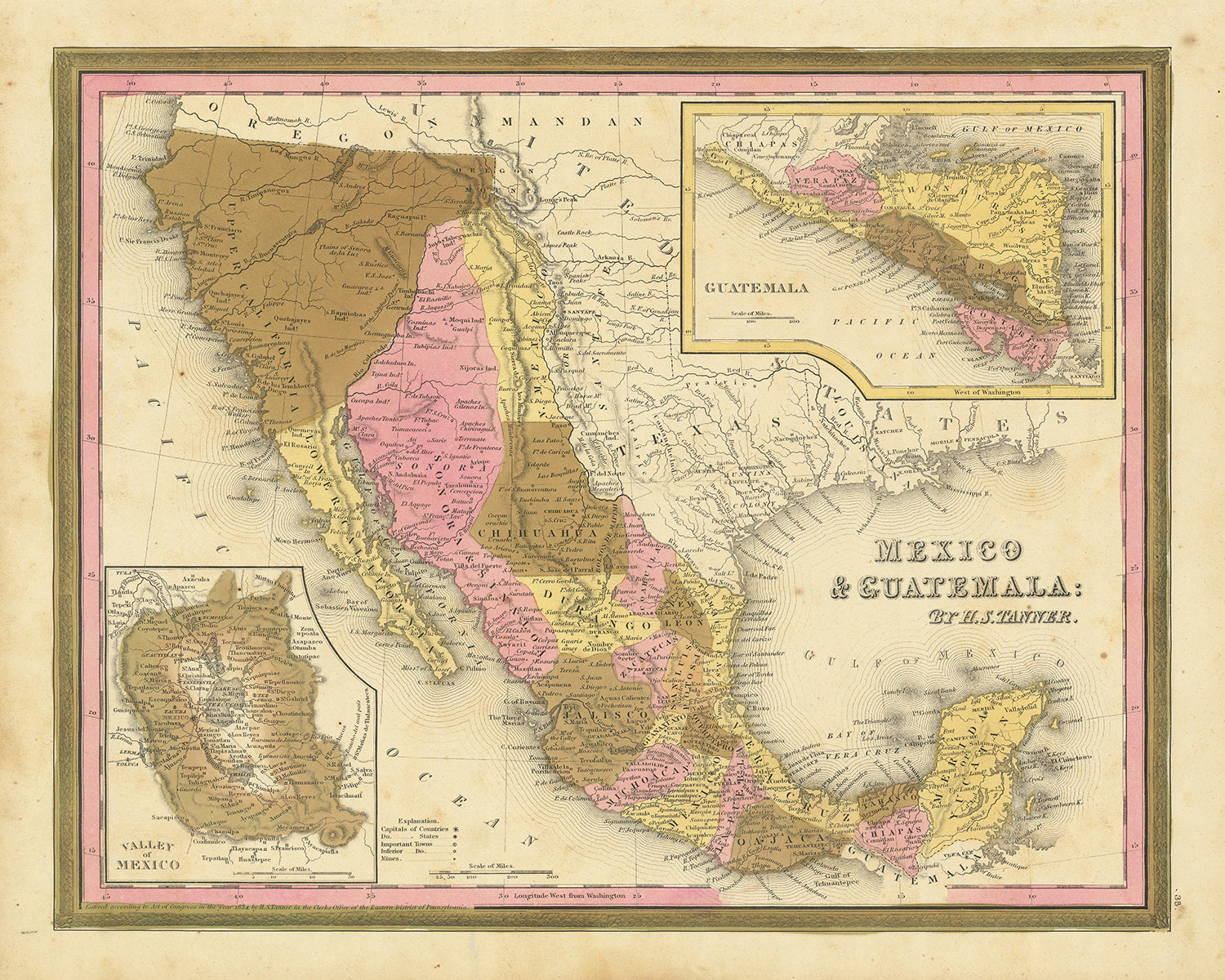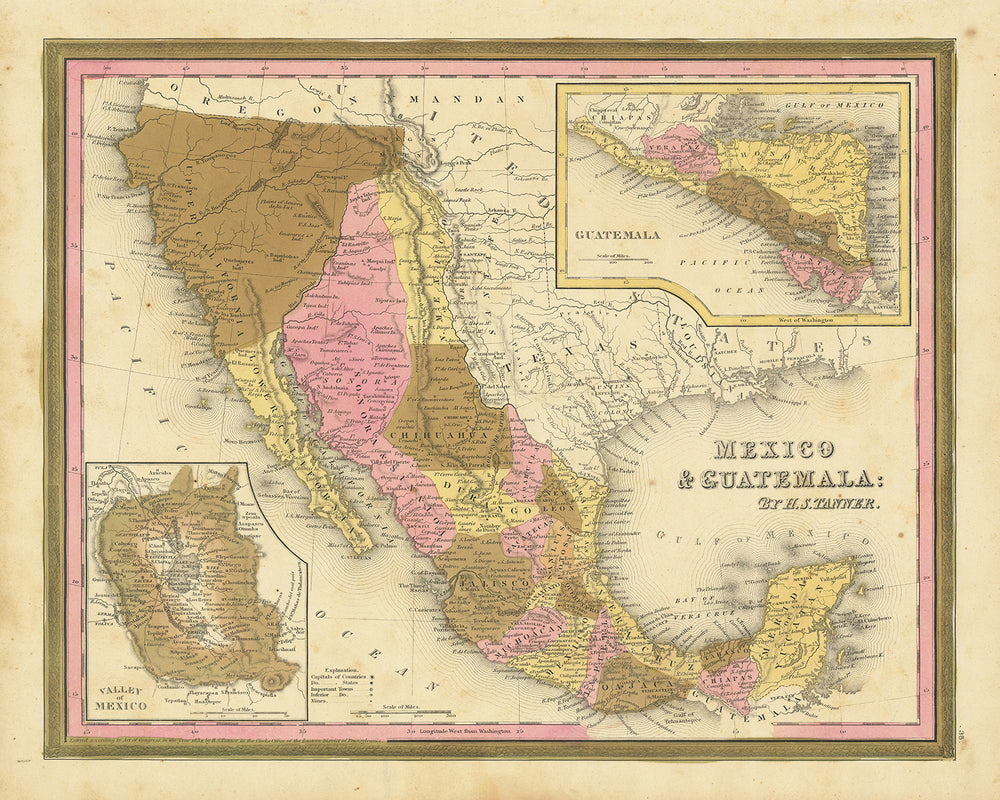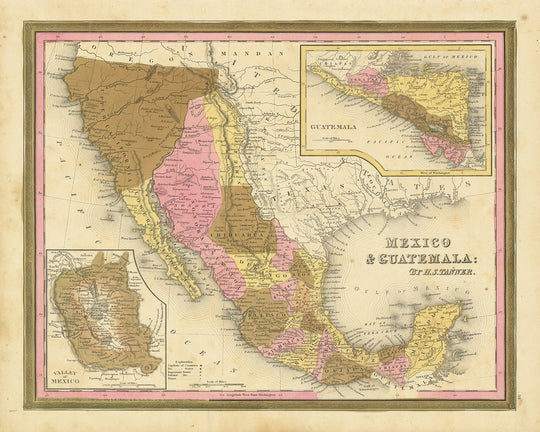- Handmade locally. No import duty or tax
- FREE worldwide delivery
- Love it or your money back (90 days)
- Questions? WhatsApp me any time
Own a piece of history
5,000+ 5 star reviews


This masterful 1839 map by H.S. Tanner stands as a richly detailed testament to a time of transformation and exploration. This region of Mexico, Guatemala, and Southwest Texas, including what would become the state of California, was in the throes of significant change. As an artifact from an era that pre-dates many modern cities, the map bears the names of early settlements and offers an intriguing opportunity to trace their evolution over time. It's not just a piece of cartography; it's a portal to the past.
What sets this map apart is not just its meticulous detail but the historical context it envelops. The 1830s was a period of considerable political flux, and this map delivers a snapshot of that time, capturing a pre-Californian United States era. Thus, the map invites dialogue and discussions about colonialism, frontier life, and the transformation of the landscape, proving to be much more than a mere decorative item.
Settlements featured
Mexico
- Mexico City (Founded 1325): Originally known as Tenochtitlán, it was the capital of the Aztec Empire, and it is now the most populous city in North America.
- Puebla (Founded 1531): Established by the Spanish in an area known for its intricate pottery and rich culinary tradition.
- Guadalajara (Founded 1532): Named after the Spanish hometown of its founder, Nuño de Guzmán, Guadalajara is now known as Mexico's cultural hub, famous for mariachi music and tequila.
- Veracruz (Founded 1519): Founded by Hernán Cortés, it was the first Spanish settlement on the mainland of the Americas.
- Monterrey (Founded 1596): Named after the Countess of Monterrei, it is now an important industrial and business hub in Mexico.
- Leon (Founded 1576): Known as the leather capital of the world.
- Zacatecas (Founded 1548): A significant city during the Spanish colonial period due to its silver mining.
- San Luis Potosi (Founded 1592): One of the centers of the Mexican War of Independence.
Guatemala
- Guatemala City (Founded 1776): The capital city, it was moved to this location after the previous capital, Antigua Guatemala, was destroyed by an earthquake.
- Antigua Guatemala (Founded 1543): Known for its well-preserved Spanish Baroque-influenced architecture.
- Quetzaltenango (Founded 1524): It was the city where the final battle took place that ended the Mayan resistance against Spanish rule.
- Livingston (Founded 1806): A unique town in Guatemala, home to the Garifuna people.
- Flores (Founded 9th Century AD): Located on a small island on Lake Petén Itzá, it was the last independent Maya state until 1697.
Southwest Texas
- San Antonio (Founded 1718): Originally a Spanish mission and colonial outpost, it is now known for The Alamo, a historic Spanish mission and fortress compound.
- Goliad (Founded 1749): Known for the Presidio La Bahía, a fort established by the Spanish to protect their missions and settlements in the region.
- Nacogdoches (Founded 1779): The oldest town in Texas, it was a significant site during the Texas Revolution.
- Victoria (Founded 1824): Named after the first president of independent Mexico, Guadalupe Victoria.
- Austin (Founded 1839): Named for Stephen F. Austin, known as the "Father of Texas", it's the state capital and a cultural and educational hub.
- Houston (Founded 1836): Named after General Sam Houston, a key figure in Texas's independence from Mexico. It's the largest city in Texas and known for its role in the space industry.
California (Then part of Mexico)
- San Diego (Founded 1769): Originally a Spanish mission and presidio, it's now the second-largest city in California.
- Los Angeles (Founded 1781): Originally a Spanish mission, it has grown into the second most populous city in the United States.
- Monterey (Founded 1770): The capital of Alta California under both Spain and Mexico, it was the site of the drafting of the California Constitution in 1849.
- San Jose (Founded 1777): Known as the first civilian town in the Spanish colony of California.
- San Francisco (Founded 1776): Originally named Yerba Buena, it was renamed to San Francisco in 1847, a year before the start of the California Gold Rush.
Highlighted features on this map include significant boundaries and natural features like the Rio Grande, the Grand Canyon, Popocatepetl and Iztaccihuatl volcanoes, as well as California's El Camino Real and Yosemite Valley.
This period between 1820 and 1850 was marked by significant events such as the Texas Revolution (1835-1836), the Mexican-American War (1846-1848), and the signing of the Treaty of Guadalupe Hidalgo in 1848. These historical events echo throughout the region encapsulated in this map, providing not only aesthetic value but a journey through history.
Please double check the images to make sure that a specific town or place is shown on this map. You can also get in touch and ask us to check the map for you.
This map looks great at all sizes: 12x16in (30.5x41cm), 16x20in (40.5x51cm), 18x24in (45.5x61cm), 24x30in (61x76cm), 32x40in (81.5x102cm), 40x50in (102x127cm), 48x60in (122x153cm) and 56x70in (142x178cm), but it looks even better when printed large.
I can create beautiful, large prints of this map up to 100in (254cm). Please get in touch if you're looking for larger, customised or different framing options.
The model in the listing images is holding the 16x20in (40.5x51cm) version of this map.
The fifth listing image shows an example of my map personalisation service.
If you’re looking for something slightly different, check out my main collection of USA and North America maps.
Please contact me to check if a certain location, landmark or feature is shown on this map.
This would make a wonderful birthday, Christmas, Father's Day, work leaving, anniversary or housewarming gift for someone from the areas covered by this map.
This map is available as a giclée print on acid free archival matte paper, or you can buy it framed. The frame is a nice, simple black frame that suits most aesthetics. Please get in touch if you'd like a different frame colour or material. My frames are glazed with super-clear museum-grade acrylic (perspex/acrylite), which is significantly less reflective than glass, safer, and will always arrive in perfect condition.
This map is also available as a float framed canvas, sometimes known as a shadow gap framed canvas or canvas floater. The map is printed on artist's cotton canvas and then stretched over a handmade box frame. We then "float" the canvas inside a wooden frame, which is available in a range of colours (black, dark brown, oak, antique gold and white). This is a wonderful way to present a map without glazing in front. See some examples of float framed canvas maps and explore the differences between my different finishes.
For something truly unique, this map is also available in "Unique 3D", our trademarked process that dramatically transforms the map so that it has a wonderful sense of depth. We combine the original map with detailed topography and elevation data, so that mountains and the terrain really "pop". For more info and examples of 3D maps, check my Unique 3D page.
For most orders, delivery time is about 3 working days. Personalised and customised products take longer, as I have to do the personalisation and send it to you for approval, which usually takes 1 or 2 days.
Please note that very large framed orders usually take longer to make and deliver.
If you need your order to arrive by a certain date, please contact me before you order so that we can find the best way of making sure you get your order in time.
I print and frame maps and artwork in 23 countries around the world. This means your order will be made locally, which cuts down on delivery time and ensures that it won't be damaged during delivery. You'll never pay customs or import duty, and we'll put less CO2 into the air.
All of my maps and art prints are well packaged and sent in a rugged tube if unframed, or surrounded by foam if framed.
I try to send out all orders within 1 or 2 days of receiving your order, though some products (like face masks, mugs and tote bags) can take longer to make.
If you select Express Delivery at checkout your order we will prioritise your order and send it out by 1-day courier (Fedex, DHL, UPS, Parcelforce).
Next Day delivery is also available in some countries (US, UK, Singapore, UAE) but please try to order early in the day so that we can get it sent out on time.
My standard frame is a gallery style black ash hardwood frame. It is simple and quite modern looking. My standard frame is around 20mm (0.8in) wide.
I use super-clear acrylic (perspex/acrylite) for the frame glass. It's lighter and safer than glass - and it looks better, as the reflectivity is lower.
Six standard frame colours are available for free (black, dark brown, dark grey, oak, white and antique gold). Custom framing and mounting/matting is available if you're looking for something else.
Most maps, art and illustrations are also available as a framed canvas. We use matte (not shiny) cotton canvas, stretch it over a sustainably sourced box wood frame, and then 'float' the piece within a wood frame. The end result is quite beautiful, and there's no glazing to get in the way.
All frames are provided "ready to hang", with either a string or brackets on the back. Very large frames will have heavy duty hanging plates and/or a mounting baton. If you have any questions, please get in touch.
See some examples of my framed maps and framed canvas maps.
Alternatively, I can also supply old maps and artwork on canvas, foam board, cotton rag and other materials.
If you want to frame your map or artwork yourself, please read my size guide first.
My maps are extremely high quality reproductions of original maps.
I source original, rare maps from libraries, auction houses and private collections around the world, restore them at my London workshop, and then use specialist giclée inks and printers to create beautiful maps that look even better than the original.
My maps are printed on acid-free archival matte (not glossy) paper that feels very high quality and almost like card. In technical terms the paper weight/thickness is 10mil/200gsm. It's perfect for framing.
I print with Epson ultrachrome giclée UV fade resistant pigment inks - some of the best inks you can find.
I can also make maps on canvas, cotton rag and other exotic materials.
Learn more about The Unique Maps Co.
Map personalisation
If you're looking for the perfect anniversary or housewarming gift, I can personalise your map to make it truly unique. For example, I can add a short message, or highlight an important location, or add your family's coat of arms.
The options are almost infinite. Please see my map personalisation page for some wonderful examples of what's possible.
To order a personalised map, select "personalise your map" before adding it to your basket.
Get in touch if you're looking for more complex customisations and personalisations.
Map ageing
I have been asked hundreds of times over the years by customers if they could buy a map that looks even older.
Well, now you can, by selecting Aged before you add a map to your basket.
All the product photos you see on this page show the map in its Original form. This is what the map looks like today.
If you select Aged, I will age your map by hand, using a special and unique process developed through years of studying old maps, talking to researchers to understand the chemistry of aging paper, and of course... lots of practice!
If you're unsure, stick to the Original colour of the map. If you want something a bit darker and older looking, go for Aged.
If you are not happy with your order for any reason, contact me and I'll get it fixed ASAP, free of charge. Please see my returns and refund policy for more information.
I am very confident you will like your restored map or art print. I have been doing this since 1984. I'm a 5-star Etsy seller. I have sold tens of thousands of maps and art prints and have over 5,000 real 5-star reviews. My work has been featured in interior design magazines, on the BBC, and on the walls of dozens of 5-star hotels.
I use a unique process to restore maps and artwork that is massively time consuming and labour intensive. Hunting down the original maps and illustrations can take months. I use state of the art and eye-wateringly expensive technology to scan and restore them. As a result, I guarantee my maps and art prints are a cut above the rest. I stand by my products and will always make sure you're 100% happy with what you receive.
Almost all of my maps and art prints look amazing at large sizes (200cm, 6.5ft+) and I can frame and deliver them to you as well, via special oversized courier. Contact me to discuss your specific needs.
Or try searching for something!















































